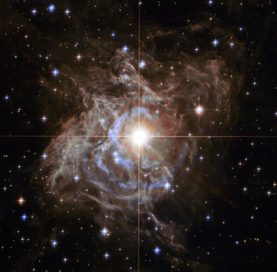Astronomers have discovered variable stars that periodically dim and brighten at frequencies close to the famed golden mean
February 9, 2015 |By Clara Moskowitz
Scholars have seen the golden ratio in nautilus shells, the Parthenon, da Vinci paintings and now in stars. A new study of variable stars observed by the Kepler space telescope found four stars that pulsate at frequencies whose ratio is near the irrational number 0.61803398875, known as the Greek letter phi, or the golden ratio (which is also sometimes referred to as the inverse of that number, 1.61803398875…).
The golden ratio had not turned up in the celestial sphere before astronomer John Linder of The College of Wooster in Ohio and his colleagues analyzed the Kepler data. The researchers looked at a class of stars called RR Lyrae that are known for their variability. Unlike the sun, which shines at a near constant brightness (a good thing for life on Earth!), these stars brighten and dim as their atmospheres expand and contract due to periodic pressure changes. Each star pulses with a primary frequency and also shows smaller brightness fluctuations occurring on a secondary frequency. The ratios between these two frequencies “are very important,” says astronomer Róbert Szabó of the Konkoly Observatory in Hungary, who was not involved in the study, “because they are characterized by the inner structure of stars—and if a star exhibits many modes, then observation of the frequencies gives very strict constraints to stellar models.” For four of the six RR Lyrae stars the researchers analyzed, the ratio of the primary to secondary frequencies was near the golden mean—within 2 percent of its value in the case of the star KIC 5520878, for example.
 The golden ratio has been a source of fascination to mathematicians, scientists and artists since the days of Pythagoras and Euclid in ancient Greece, although whether or not it is actually present in all of the places people have claimed to find it is debatable. “The golden ratio has a long history in disciplines ranging from the physics of crystals to visual arts,” says astrophysicist Mario Livio of the Space Telescope Science Institute in Baltimore, who wrote the 2002 book The Golden Ratio: The Story of Phi, The World's Most Astonishing Number. Two numbers have the golden mean if the ratio between them is the same as the
The golden ratio has been a source of fascination to mathematicians, scientists and artists since the days of Pythagoras and Euclid in ancient Greece, although whether or not it is actually present in all of the places people have claimed to find it is debatable. “The golden ratio has a long history in disciplines ranging from the physics of crystals to visual arts,” says astrophysicist Mario Livio of the Space Telescope Science Institute in Baltimore, who wrote the 2002 book The Golden Ratio: The Story of Phi, The World's Most Astonishing Number. Two numbers have the golden mean if the ratio between them is the same as the
 ratio between their sum and the larger of the two numbers—in rectangular terms, long is to short as the whole is to the long. “The golden ratio is special in that it is in some sense the most irrational of all irrational numbers,” Livio says. An irrational number is one that cannot be expressed as a ratio of whole numbers. But some irrational numbers are easy to approximate using rational numbers whereas others are hard. The golden ratio is the irrational number that is hardest to approximate with rational numbers.
ratio between their sum and the larger of the two numbers—in rectangular terms, long is to short as the whole is to the long. “The golden ratio is special in that it is in some sense the most irrational of all irrational numbers,” Livio says. An irrational number is one that cannot be expressed as a ratio of whole numbers. But some irrational numbers are easy to approximate using rational numbers whereas others are hard. The golden ratio is the irrational number that is hardest to approximate with rational numbers.
via Strange Stars Pulsate According to the “Golden Ratio” – Scientific American.

